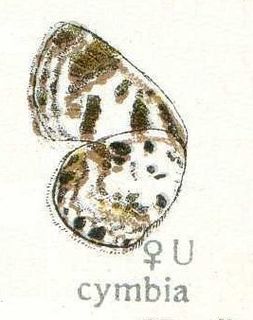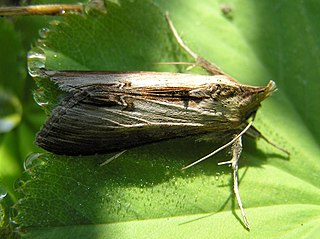
Apamea crenata, known as the clouded-bordered brindle, is a moth in the family Noctuidae. It is distributed throughout the Palearctic realm. In the North it crosses the Arctic Circle, in the Mediterranean it is found only in cool locations and mountains avoiding very hot areas. In the Alps, it rises to an altitude of about 2000 metres.

Miletus symethus, the great brownie, is a small butterfly found in India that belongs to the lycaenids or blues family. The species was first described by Pieter Cramer in 1777.

Niphanda cymbia, the pointed Pierrot, is a small butterfly found in northern India, Burma and northern Borneo that belongs to the lycaenids or blues family.

Cucullia asteris, or star-wort, is a moth of the family Noctuidae. The species was first described by Michael Denis and Ignaz Schiffermüller in 1775. It is found through the Palearctic including Japan.

Nycteola revayana, the oak nycteoline, is a moth of the family Nolidae. The species was first described by Giovanni Antonio Scopoli in 1772. It is found from Europe and east across the Palearctic to Japan and India.
Repnoa is a genus of moths in the family Megalopygidae. It contains only one species, Repnoa imparilis, which is found in French Guiana.
Megalopyge braulio is a moth of the Megalopygidae family. It was described by Schauss in 1924. It is found in Paraguay.
Megalopyge torva is a moth of the family Megalopygidae. It was described by Schaus in 1912. It is found in Costa Rica.
Megalopyge tharops is a moth of the family Megalopygidae. It was described by Caspar Stoll in 1782. It is found in French Guiana and Brazil.
Mesoscia lorna is a moth of the Megalopygidae family. It was described by Schaus in 1905. It is found in French Guiana.
Podalia albescens is a moth of the family Megalopygidae. It was described by William Schaus in 1900. It is found in Brazil.
Podalia amarga is a moth of the family Megalopygidae. It was described by Schaus in 1905.
Podalia lanocrispa is a moth of the family Megalopygidae. It was described by E. Dukinfield Jones in 1912. It is found in Brazil.
Podalia mallas is a moth of the family Megalopygidae. It was described by Herbert Druce in 1899. It is found in Brazil.
Podalia nivosa is a moth of the family Megalopygidae. It was described by E. Dukinfield Jones in 1912. It is found in Brazil.

Podalia orsilochus is a moth of the Megalopygidae family. It was described by Pieter Cramer in 1775. It is found in Mexico, Costa Rica, Brazil, Guyana and Venezuela.
Podalia schadei is a moth of the Megalopygidae family. It was described by William Schaus in 1924. It is found in Paraguay.
Podalia thanatos is a moth of the Megalopygidae family. It was described by William Schaus in 1905. It is found in Costa Rica and Guyana.
Podalia tympania is a moth of the family Megalopygidae. It was described by Herbert Druce in 1897. It has been recorded from Peru and Mexico.
Podalia walkeri is a moth of the Megalopygidae family. It was described by Carlos Berg in 1882 and is found in Brazil.





